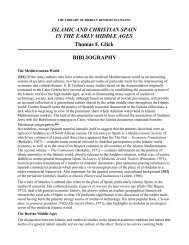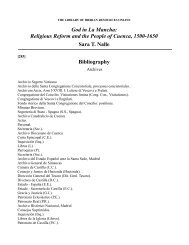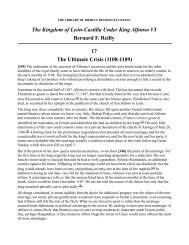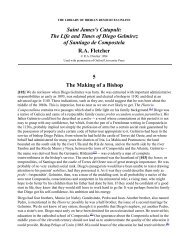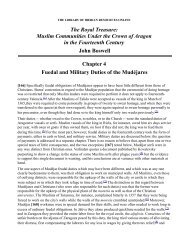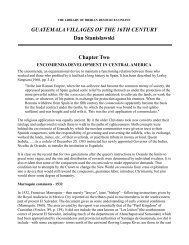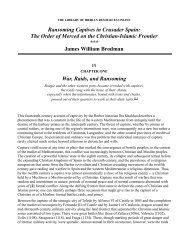The Cluniac Priories of Galicia and Portugal - The Library of Iberian ...
The Cluniac Priories of Galicia and Portugal - The Library of Iberian ...
The Cluniac Priories of Galicia and Portugal - The Library of Iberian ...
Create successful ePaper yourself
Turn your PDF publications into a flip-book with our unique Google optimized e-Paper software.
We might hypothesize therefore that in the course <strong>of</strong> a traverse <strong>of</strong> the Peninsula in 1205 Abbot Hugh V,<br />
personally witnessing the troubled conditions there, <strong>and</strong> the ostensible failure <strong>of</strong> the dual provincial<br />
system, ordered a return to the original single <strong>Iberian</strong> Province <strong>of</strong> Hispania; <strong>and</strong> that this explains why<br />
no explicit reference to the cameraria Gallecie or its chamberlain occurs after 1205. <strong>The</strong>re are however<br />
two objections to dating the extinction <strong>of</strong> the Luso-Gallegan circumscription this early. <strong>The</strong> first is that<br />
we have absolutely no evidence, Burgundian or peninsular, that Hugh's trip was ever made; even with<br />
our fragmentary documentation some reflection <strong>of</strong> this first abbatial crossing <strong>of</strong> the Pyrenees since<br />
Peter the Venerable's visit <strong>of</strong> [348] 1142 might be expected. <strong>The</strong> second is that Santa María de Nájera,<br />
the seat <strong>of</strong> the Gallegan camerarius, seems to be in a relatively stable state ca. 1205, <strong>and</strong> hence unlikely<br />
to attract the abbot's unfavorable attention. From the turn <strong>of</strong> the century the priory had been under the<br />
capable rule <strong>of</strong> a native Riojan, Semeno (Romance: Xemeno, Jimeno), apparently the very first<br />
Hispano-<strong>Cluniac</strong> prior <strong>of</strong> peninsular birth, under whom it recovered or first acquired a number <strong>of</strong><br />
revenue-producing patrimonies, as we learn from Semeno's lengthy report on his administration <strong>of</strong> the<br />
Nájeran temporal. (150) To be sure, this is a statement implying recovery from earlier troubles; however,<br />
between the end <strong>of</strong> 1202, by which time Semeno had retired to be replaced by a Frenchman, Girard,<br />
(151)<br />
<strong>and</strong> 1205, Santa María could hardly have declined so speedily as to discredit her capacity to<br />
govern Provincial communities. Thus, unless we argue that her priors, however effective in Riojan<br />
affairs, failed badly in meeting their responsibilities in the Galaico-Portuguese west, the necessity for<br />
suppressing the second carnerario, at this time is difficult to discover.<br />
But if the cameraria Gallecie survived, as in the absence <strong>of</strong> testimony to the contrary we may suppose<br />
it did, Hugh V's projected journey, its life cannot have extended beyond the abbatiate <strong>of</strong> Gerard <strong>of</strong><br />
Fl<strong>and</strong>ers (1215-1220). <strong>The</strong> evidence for this, indirect <strong>and</strong> intricate, comes almost wholly not from<br />
<strong>Galicia</strong> <strong>and</strong> <strong>Portugal</strong>, but from Santa María de Nájera, which in the first half <strong>of</strong> the 13th century<br />
constitutes our principal key to the fate <strong>of</strong> the Galaico-Portuguese cameraria. Here three unstudied<br />
episodes, all <strong>of</strong> which can be linked to the Spanish policies <strong>of</strong> Abbot Gerard as regards Hispano-<br />
<strong>Cluniac</strong> administrative reorganization, require close examination. <strong>The</strong>se are (i) the intervention at<br />
Nájera <strong>of</strong> the <strong>Cluniac</strong> uisitatores Eustorgius <strong>and</strong> Aymeric; (ii) the abbot's own journey to the Peninsula;<br />
<strong>and</strong> (iii) the activities at Nájera <strong>and</strong> Villafranca <strong>of</strong> the monk John, Gerard's appointee as camerarius<br />
Hispanie.<br />
[349] (i) <strong>The</strong> Eustorgius-Aymeric visitation. <strong>The</strong> sudden appearance at Nájera <strong>of</strong> two French <strong>Cluniac</strong><br />
priors, Eustorgius <strong>of</strong> Saint-Flour in Auvergne, who also bears the title <strong>of</strong> camerarius in Hispania, <strong>and</strong><br />
Aymeric <strong>of</strong> Saint-Germain, (152) is the first example I know for Spain <strong>of</strong> the abbey's later practice <strong>of</strong><br />
sending pairs <strong>of</strong> annual visitors to inspect the dependencies. Since the exercise <strong>of</strong> authority at Nájera by<br />
a chamberlain acting in Hispania implies the absence <strong>of</strong> a resident prior-chamberlain there, <strong>and</strong> Santa<br />
María's re-incorporation into Hispania, it is essential to extract what information we can regarding the<br />
date <strong>and</strong> circumstances <strong>of</strong> this visit.<br />
Virtually all the evidence consists <strong>of</strong> two marginal annotations in Semeno <strong>of</strong> Nájera's just mentioned<br />
account <strong>of</strong> his patrimonial administration while prior. First published by Havet in 1883 from the British<br />
Museum original, (153) <strong>and</strong> again in the Chartes de Cluny, (154) this relatively lengthy document consists<br />
<strong>of</strong> (a) a detailed account <strong>of</strong> all properties recovered or gained, buildings constructed (particularly after a<br />
great fire swept the town) <strong>and</strong> new collazos acquired, as a result <strong>of</strong> Semeno's own purchases or gifts<br />
secured by him; <strong>and</strong> (b) a statistical survey by individual domains showing progress made in<br />
agricultural equipment, livestock <strong>and</strong> crop output between the beginning <strong>and</strong> end <strong>of</strong> Semeno's prioracy.<br />
Two annotations have been added in this document's margins at some time subsequent to its<br />
composition, by another h<strong>and</strong>. (155) <strong>The</strong> first, placed near the close <strong>of</strong> the domanial survey, reads thus:<br />
"Hec omnia probata fuerunt sicut suprascripta sunt coram priore Sancti Flori, carnerario in Hispania,<br />
domino Eustorgio et fratre Aymerico, priore Sancti Germani, et magistro Alano et omni conuentu



